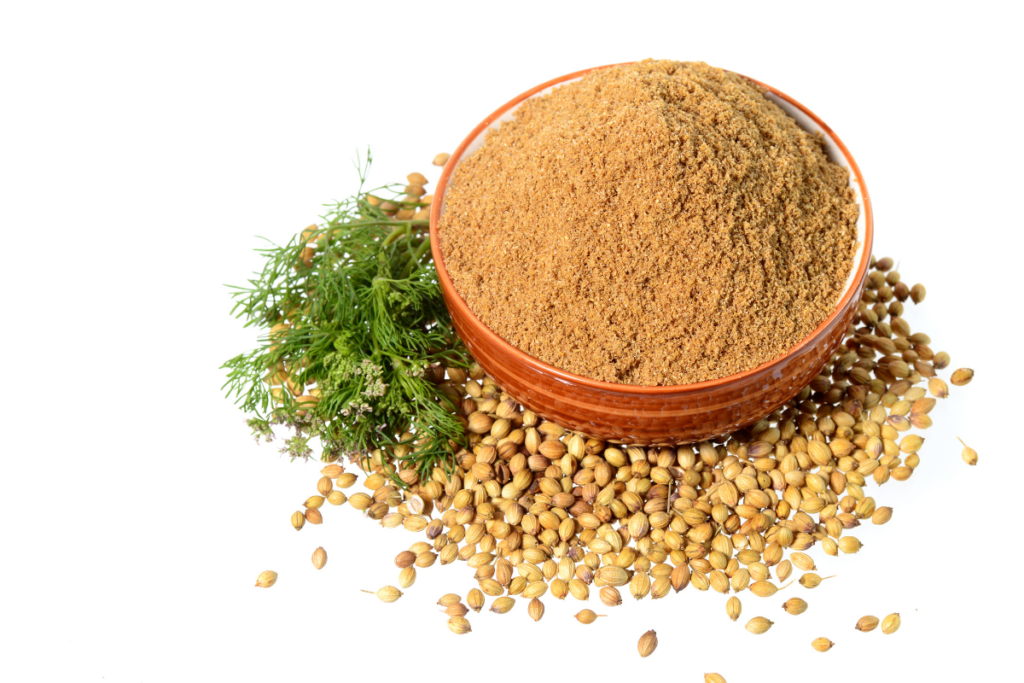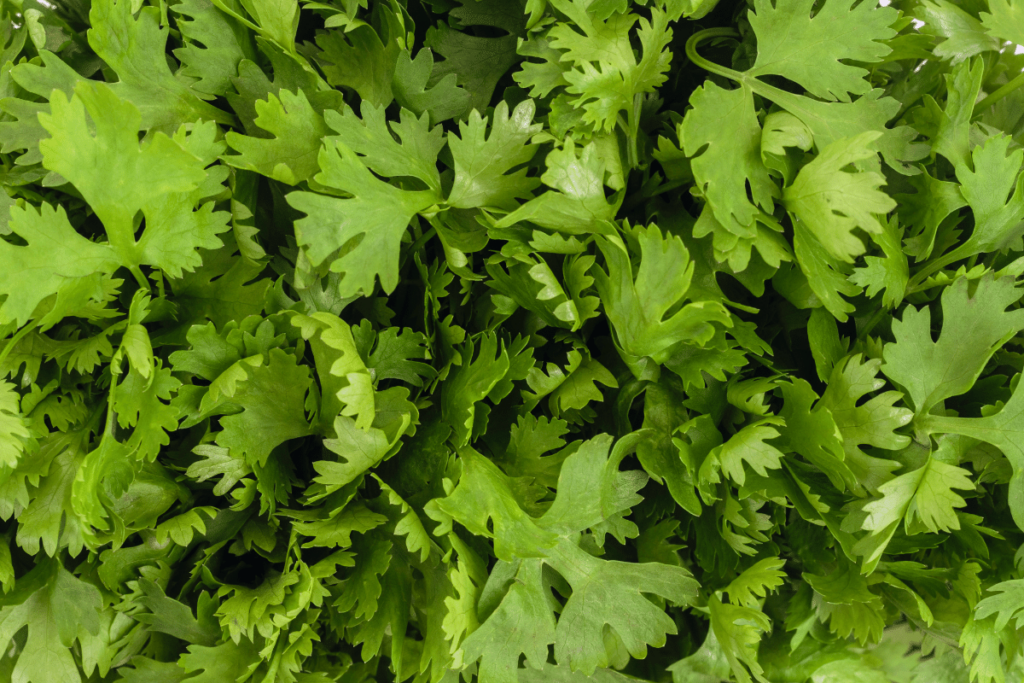Coriander and Cilantro are some of the most popular herbs used in the culinary world and are also a well-known herb that is easy to cultivate at home. In this article, let’s take a closer look at coriander vs cilantro.

Cilantro’s fronds can be best described as bright green with flat leaves which resemble miniature versions of Italian parsley. These herbs are notoriously known as the ones that impart that soapy flavor to some dishes.
Coriander, on the other hand, comes from the seed of a similar plant as that of Cilantro! The seeds of the cilantro plant are called coriander seeds. Essentially, Cilantro is the leaf, and Coriander is the seed. They come from the same plant, scientifically called as the Coriandrum sativum. It’s the multiple purposes of this plant that may cause the confusion.
Why the confusion?
As earlier mentioned, the confusion arises because the Coriander sativum and its different parts have multiple uses. Therefore, one may ask, “why aren’t they called the similar name” or “why aren’t the leaves and stems called coriander if they come from the same coriander plant?”.
This mostly comes down to history and locale, as in the North America, they have named the herb and the seeds Cilantro and Coriander, respectively. For the rest of the globe, both the leaves and the seeds are called Coriander. A fun fact is that Cilantro is the Spanish word for Coriander.
Cilantro vs. Coriander: Taste Difference

In actuality, both the leaves and the seeds impart a citrus taste. Some, but not all, will taste a soapy flavor with Cilantro, and it is due to genetics. People who perceive the taste of Cilantro to be soapy have a higher number of a certain variation of olfactory receptors that is responsible for soapy-flavored aldehydes found in Cilantro. To others who do not have this genetic quirk, the Cilantro tastes truly like how a citrus tastes.
Coriander, on the contrary, is more floral and lemony, which is entirely different from that of the leaves. For this reason, it is generally not a smart idea to substitute the leaves for the seeds and vice versa. They’re part of the one same plant, but they’re entirely unique in that they both have wildly different applications.
Related: Growing Rosemary From Cuttings: The Complete Guide and Know-Hows
Cilantro Vs. Coriander: Coriander Use

The seeds of Coriander are commonly utilized in many rice dishes and are a common spice in curries, soups, pickles, and marinades like your curry powder, caraway, and cumin. Depending on the intensity of flavor that you’re trying to achieve, they are used toasted, crushed, whole, or powdered up. Ground coriander seeds, dried seeds, and even coriander roots are also often used for culinary purposes. Each recipe will specify what type to use, but sometimes, only your preferences of the intensity of flavor will dictate how you use it.
If you already have a coriander plant at your own home, it will be easy for you to process your own crushed, ground, or whole version. The best way to break this spice down is using mortar and pestle, but a food processor also works. Just remember that before you can use the coriander seed, it first has to be thoroughly dried.
Cilantro Vs. Coriander: Cilantro Use

Cilantro, whether whole or chopped, is commonly used in a lot of Mexican dishes and Asian cuisine due to the unique citrusy taste it provides. The leaves, and even the stems, impart a ton of flavor, and you can use sprigs of it as a garnish to your final dish. It is used in salsas, spreads, sauces, dips, soups, and even marinades as well.
Since it is a fresh herb, make sure to add it just at the end of your cooking. Almost any fresh herbs quickly lose their flavor, especially in hot dishes, because most of the flavor compounds in these herbs are volatile and quickly vaporize to the air. Also, take note of who you’re serving your dish to, as any unlucky guest with a genetic variation to their taste receptors will perceive nothing from your dish except for that soapy aftertaste.
Cilantro Vs. Coriander: Nutrient Profiles
The nutrient profiles of both Cilantro and Coriander, although they come from the same plant, are different and vary. The nutrients in the cilantro leaves differ distinctly from the coriander seeds.
The Cilantro leaves were discovered to have more levels of vitamins, such as vitamins E, A, and K, but lower mineral levels. On the contrary, the coriander seeds have lower vitamin levels, but higher levels of minerals, such as calcium, iron, and magnesium.
It is also good to note that fresh cilantro leaves comprise of 92.2% water. On the other hand, fresh coriander sees have 8.9% water. This is the main reason why your Cilantro has a low mineral level by weight since water does not contain any minerals nor calories.
Related: Decoration, Spice, Medicine – Get To Know 17 Types Of Versatile Sage Plants
How do I get my coriander plant to grow seeds?

As with any plant grown indoors or outdoors, the most effective way to coax it to develop flowers and produce seeds is to render optimal care. If you’re trying to grow Coriander outdoors, it is best to keep them in containers so that when the threat of frost comes, you can put them indoors in the cozy warmth of your home. This way, you always have a fresh herb ready to be used.
Light Conditions
For lighting conditions, Coriander prefers to have bright but indirect light and will definitely hate direct sunlight. This will degrade the flavor of the leaves and, much worse, it will burn and damage the herb. Therefore, it is best to select a window that is east-facing, a patio, or a garden space, or place it under one of your taller plants or trees, as long as it will receive shade from bright midday light.
Soil Conditions
As for soil conditions, you will want to utilize a soil mix that does not let water sit for too long. The better draining the soil is, the lesser your herb will be prone to root rotting. The plant wants moist soil but one that doesn’t get too soggy. A rich and loamy soil will do the job.
Watering Conditions
As for watering, water the plant only when you observe that the first inch of the topsoil gets dry. If you’re trying to grow the herb for seeds, then go lighter on the watering as its flowers start to bloom. However, do your ultimate best not to let the herb completely dry out.
Should I plant one plant for cilantro and one plant for coriander?
If you are trying to grow both the plants and the seeds, it is best to keep two separate plants for each specific part. One plant you can use for the leaves, taking good care not to harvest half of the plant so as not to overstress it. For the other plant, you can let “bolt” and seed without risking the plant being overharvested.
Any other tips for helping me grow my coriander plant?

Fertilizing is not necessary for the humble Coriander, but the benefit of fertilizing is that it helps you grow a steady and healthy supply of herbs. After your plant turns a month and a half old, apply an organic, balanced, water-soluble fertilizer every other week at most. Any more than this, and you run the risk of fertilizer burn.
There is also no need to worry regarding propagation because if you regularly harvest your coriander leaves, then you have already done most of the pruning that you will ever need to do. However, you can strategize your pruning so as to dictate how the plant grows. For example, if it grows tall and leggy, you can prune the top off those stems, and the herb will grow bushier.
If you want more out of this plant, then you may want to propagate! They easily grow from the seeds, so there’s practically no need to propagate this plant any other way. It often reseeds and is notorious for growing on its own for a week. Leave it on its own, and it will grow the following year again. You can also harvest its seeds and plant them the next year.
How do you harvest Cilantro leaves?

To harvest, pick off the leaves after a month and a half after planting. The younger the leaves, the better the flavor, so you can opt to go for those first. There is no need for a cutting implement as you can simply just pinch them off. Others will take only what they need, while others will chop a whole bunch at once.
How do you harvest Coriander seeds?

Seeds will typically be ready in three months from planting. Immature seeds will be bitter, so it is better to let them mature first. By the time seeds mature, the plant will have already dried up. Before the seed pods open, the seeds will be ready for harvesting. Once cut, let the seed head dry out in a paper bag in a dry place. Eventually, after drying, the seeds will release in the paper bag.
How do you store Cilantro leaves and Coriander seeds?
To store the leaves, they can be kept in the fridge for a week. If you keep the leaves like a flower in a glass with water, the leaves will stay fresh for longer. Remove wilting or dying leaves so as not to affect other leaves. The leaves don’t retain their flavors when dried and will definitely keep them when frozen. To do so, just chop the leaves up and place them in an ice cube tray. Put some cooking liquid or water in the tray in the freezer.
To store the seeds, ensure the seeds are completely dried before storing them in an airtight container and place them somewhere cool and dark. They will last for a few years. It’sIt’s that simple!
Will my coriander grow flowers and seeds when grown indoors?
With certainty! Coriander is one of the most well-known herbs, especially for an indoor herb garden, and it happens to seed without the aid of pollinators. So you will never need to worry about whether you want your Coriander grown indoors or outdoors unless space is a concern.
You will always be able to harvest coriander seeds either way. Having this herb inside your home will not only provide a fresh and fragrant scent in your kitchen but will also expand the variety of your meals and open up more creative ideas!
Summary Of Coriander Vs. Cilantro
| Coriander | Cilantro | |
| Plant Source | Same plant | Same plant |
| Plant Part | Seed | Leaf |
| Taste | Floral and lemony | Citrusy |
| Vitamin content | Less vitamins | More vitamins |
| Mineral content | More minerals | Less minerals |
CONCLUSION
As hopefully illustrated in this article, we hope that we have cleared up the confusion regarding the Cilantro vs. Coriander debate. Not only that, but we also hope that we have opened up some beautiful ways of not only how to use both Coriander and Cilantro but also how to grow them in your homes.
This will surely open up new ways for you not only to cook but also to grow a wonderful herb garden! So now, go out there and flex your newfound culinary and gardening muscles!
Editor’s Recommendations
25 Tasty Mint Plants (Including Pictures)







